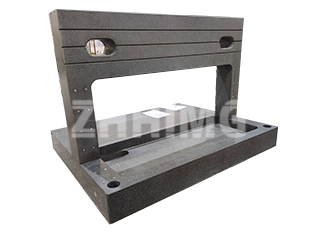Granite precision platforms are the cornerstone of ultra-precision measurement, CNC machining, and industrial inspection. However, the size of the platform—whether small (e.g., 300×200 mm) or large (e.g., 3000×2000 mm)—significantly affects the complexity of achieving and maintaining flatness and dimensional accuracy.
1. Size and Precision Control
Small granite platforms are relatively easier to manufacture and calibrate. Their compact size reduces the risk of warping or uneven stress, and precise hand-scraping or lapping can quickly achieve micron-level flatness.
In contrast, large granite platforms face multiple challenges:
-
Weight and Handling: A large platform can weigh several tons, requiring specialized handling equipment and careful support during grinding and assembly.
-
Thermal and Environmental Sensitivity: Even minor temperature fluctuations can cause expansion or contraction across a large surface, impacting flatness.
-
Support Uniformity: Ensuring the entire surface is evenly supported is critical; uneven support can lead to micro-bending, affecting precision.
-
Vibration Control: Large platforms are more susceptible to environmental vibrations, requiring anti-vibration foundations or isolated installation areas.
2. Flatness and Surface Uniformity
Achieving uniform flatness on a large platform is more difficult because the cumulative effect of small errors across the surface increases with size. Advanced techniques such as laser interferometry, autocollimators, and computer-aided lapping are typically used to maintain high precision over large spans.
3. Application Considerations
-
Small Platforms: Ideal for laboratory measurement, small CNC machines, optical instruments, or portable inspection setups.
-
Large Platforms: Required for full-scale machine tools, large coordinate measuring machines (CMMs), semiconductor equipment bases, and heavy-duty inspection assemblies. Ensuring long-term accuracy involves controlled temperature, vibration isolation, and careful installation.
4. Expertise Matters
At ZHHIMG®, both small and large platforms undergo meticulous manufacturing and calibration in temperature- and humidity-controlled workshops. Our experienced technicians use precision hand-scraping, grinding, and electronic leveling to guarantee stability and flatness, regardless of platform size.
Conclusion
While both small and large granite platforms can achieve high precision, larger platforms present greater challenges in terms of handling, flatness control, and environmental sensitivity. Proper design, installation, and professional calibration are essential to maintain micron-level accuracy across any size.
Post time: Oct-11-2025

